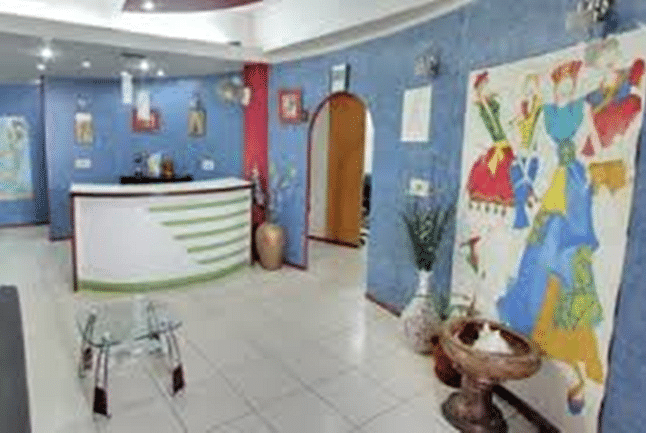MBA in Interior Designing: Course Details, Eligibility, Admission, Fees

MBA in Interior Designing is a two-year postgraduate program aimed at imparting a comprehensive understanding of interior design principles and business strategies. The curriculum covers various topics including spatial planning, design aesthetics, materials selection, project management, and sustainable design practices. Graduates are equipped with a holistic skill set to excel in the dynamic field of interior design.
Admission procedures for an MBA in Interior Designing vary among universities, with some considering merit and others requiring candidates to clear management entrance exams. General category students need a minimum of 50% in their bachelor's degree, while reserved category candidates have relaxed criteria. The MBA in Interior Designing tuition fee ranges from INR 1 - 10 LPA.
Table of Contents
- What is an MBA in Interior Designing?
- MBA in Interior Designing Eligibility Criteria
- Why Pursue an MBA in Interior Designing?
- MBA in Interior Designing Admission 2023
- MBA in Interior Designing Entrance Exam
- Top MBA in Interior Designing Colleges with Fee Details
- MBA in Interior Designing Cutoff
- MBA Interior Designing Syllabus and Subjects
- MBA in Interior Design vs. MBA in Design Management
- Courses After MBA in Interior Designing
- MBA in Interior Designing Salary in India
- Careers After Completing MBA in Interior Designing
- Scholarships for MBA in Interior Designing
- Skills to be the Best MBA in Interior Designing Graduate
MBA in Interior Designing Course Details
| Degree | Masters |
| Full Form | Master of Business Administration in Interior Designing |
| Duration | 2 Years |
| Age | No age limits |
| Entrance Exam | CAT, MAT, XAT, ATMA |
| Subjects Required | Bachelor's Degree |
| Minimum Percentage | 50% marks in Bachelor’s degree from a recognized university. [Relaxations for the Reserved Category] |
| Average Fees | ₹1.5 - 16 LPA |
| Similar Options of Study | MBA in Design Management |
| Average Salary | INR 3 - 12 LPA |
| Employment Roles | Interior Design Director, Design Consultant, Project Manager, Set Designer, Spatial Planner |
| Top Recruiters | Livspace, Homelane, FlipSpace Glue Design, Big Basket, Reliance Retail SFC Group, BBQ, Lemon Tree Hotels, JLL, Tesco, TCS |
What is an MBA in Interior Designing?
Spanning a comprehensive curriculum of four semesters, an MBA in Interior Designing delves into subjects such as Interior Design Strategy, Project Management, Financial Planning, and Sustainable Design Practices. These immersive studies empower students with the expertise required to assume pivotal roles including Interior Design Director, Project Manager, and Design Consultant.
MBA in Interior Designing falls under the umbrella of MBA courses and its graduates are primed to spearhead projects, translate vision into reality, optimize design aesthetics, and ensure impeccable execution.
MBA in Interior Designing Eligibility Criteria
Pursuing an MBA in Interior Designing requires meeting some important eligibility requirements. While the outline below provides an overview, it's important to acknowledge that specific prerequisites may vary among institutions. Here's a glimpse of the MBA in Interior Designing eligibility criteria:
- Attainment of a bachelor's degree from a recognized university.
- Minimum aggregate score of 50% in the bachelor's degree, with relaxations of 5% available for candidates from reserved categories.
- Scores of entrance exams, such as CAT, MAT, CMAT, NMAT, and ATMA, are often required, though specific exam preferences may differ across universities.
Why Pursue an MBA in Interior Designing?
Getting an MBA in interior design allows you to strategically combine creative and commercial knowledge. This program offers a platform to develop a special skill set, whether you're an ambitious design innovator, a career switcher, a business-minded creative, or an industry explorer. Listed below are some reasons why one can consider pursuing an MBA in Interior Designing:
- Market Growth: The Indian interior design market reached US$ 28.6 Billion in 2022 and is projected to expand to US$ 51.4 Billion by 2028, displaying a robust CAGR of 10.3% during 2023-2028.
- Versatile Expertise: Interior design involves a fusion of artistic vision, scientific understanding, and precise execution. It encompasses tasks like planning, decoration, and construction administration to create functional and aesthetically appealing spaces.
- Abundant Opportunities: The interior design field in India offers a plethora of career options, with over 15,000 available jobs. In-demand profiles include 3D Interior Designer and Interior Architects, with 850 vacancies for the former and 226 for the latter, as reported on LinkedIn.
- Rewards and Notable Employers: Interior designers in India earn an average salary of INR 3 LPA to INR 12 LPA. Prominent companies such as Unity Interiors, Liv Space, Eternal DESIGNS, Newmat India, and others provide promising platforms for career advancement within the industry.
MBA in Interior Designing Admission 2023
MBA Interior Designing admission involves a structured procedure that takes into account exam scores, academic achievements interviews, and group discussions. While the admission process may vary across institutions, the following is a general outline of the steps involved:
- Step 1 - Eligible candidates need to submit their applications through online applications by submitting details through the institution’s official admission portal. For offline applications, candidates can obtain and submit physical forms at the institution's admissions office.
- Step 2 - Candidates need to appear for necessary entrance exams such as CAT or MAT to evaluate their competencies.
- Step 3 - Selected candidates are called to participate in group discussions and personal interviews for final selection.
It is to be noted that specific institutions might introduce additional criteria or rounds. Candidates should review the institution's guidelines for accurate and current information.
MBA in Interior Designing Entrance Exam
Admission processes for the MBA in Interior Designing program can differ based on each institution's unique approach. Some institutions utilize their own internal exams to gauge aptitude and knowledge, while others consider widely recognized entrance tests like CAT, MAT, XAT, and CMAT. Moreover, specialized entrance examinations designed specifically for the field of interior design also find relevance.
The following table provides a clear overview of the common entrance exams applicable to the pursuit of an MBA in Interior Designing:
|
Entrance Exam |
Registration Date |
Accepting Colleges |
Registration Details |
|
CAT |
Aug 2 - Sep 13, 2023 |
University of Mysore, Pearl Academy |
|
|
MAT |
Aug 17 - Sep 14, 2023 |
Pearl Academy |
|
|
TANCET |
February 2024 |
Bharathiar University |
Top MBA in Interior Designing Colleges with Fee Details
Selecting an appropriate institution for an MBA in Interior Designing is pivotal, significantly shaping the academic and professional journey. The following curated list features esteemed colleges and universities offering comprehensive MBA in Interior Designing programs. This list highlights academic prowess and provides insights into the fee structure, aiding prospective students in an informed choice aligned with aspirations.
Outlined below are some prominent institutions offering MBA in Interior Designing programs, along with a glimpse into their fee structure:
| University | Admission Fee | Miscellaneous Fee (per annum) | Average Tuition Fee | Total Program Fee |
| University of Mysore | INR 13,310 | INR 29,000 | INR 44,000 | INR 95,000 |
| INSD | INR 1,000 | INR 5,000 | INR 1.5 LPA | INR 3 LPA |
| Bharatiar University | INR 1,800 | INR 22,560 | INR 64,215 | INR 1.3 LPA |
| Pearl Academy | INR 92,000 | INR 1 LPA | INR 3.6 LPA | INR 10 LPA |
[These figures are approximate values and subject to change at the institution’s discretion]
MBA in Interior Designing Cutoff
For admissions to an MBA in Interior Designing some of the colleges accept admissions via entrance exams such as CAT, MAT and more. Listed below are the cut-off scores for institutions based on entrance exams
|
Entrance Exam |
Expected Cut-Off 2023 |
|
TANCET |
37.5+ Percentile |
|
MAT |
50+ Percentile |
|
CAT |
70+ Percentile |
MBA Interior Designing Syllabus and Subjects
The MBA in Interior Designing syllabus spans two years, encompassing four semesters, and offers an immersive exploration of the interior design industry. By strategically blending foundational and specialized courses, students develop a strong knowledge base while honing expertise in specific domains.
For a detailed overview of the MBA in Interior Designing syllabus, refer to the table below:
|
Subjects |
Topics Covered |
|
Management Fundamentals |
Organizational Behavior, Business Communication, Financial Management, Economics, Marketing Management, Human Resource Management, Operations Management, Strategic Management |
|
Design and Architecture |
History of Architecture, Design and Space Planning, Materials and Construction |
|
Technology and Tools |
Computer for Business, Service System and Codes, CAD and Visualisation |
|
Interior Design Specializations |
Estimation and Costing, Furniture Design and Detailing, Interior Project Management. |
|
Business Structure & Professional Practice |
Business Environment, Binding Procurement and Practice in Architecture, Architects Act and COA regulations. |
MBA in Interior Design vs. MBA in Design Management
Comparing two courses, such as MBA in Interior Designing and MBA in Design Management, offers a vital lens to discern the distinct merits of pursuing an MBA in Interior Designing. This course comparison not only underscores the unique attributes and career trajectories each specialization presents but also provides a comprehensive understanding of how an MBA in Interior Designing equips individuals with the specialized knowledge and skills essential for success in the dynamic world of interior design.
Listed in the table below is a course comparison of an MBA in Interior Designing with an MBA in Design Management
|
Parameters |
MBA in Interior Designing |
MBA in Design Management |
|
Full Form |
Masters of Business Administration in Interior Designing |
Master of Business Administration in Design Management |
|
Overview |
Integrates aesthetic design, sustainability, and project management for holistic interior solutions. |
Synergizes creativity and strategic acumen, fostering leadership in innovative design endeavors. |
|
Duration |
2 years |
2 years |
|
Eligibility |
50% in graduation for unreserved category and 45% for SC/ST/PwD students |
50% in graduation for unreserved category and 45% for SC/ST/PwD students |
|
Job Role |
Interior Design Director, Design Consultant, Project Manager roles; impactful spatial transformations. |
Design Manager, Strategist, Innovation Consultant; driving design-led innovation across sectors. |
|
Average Fee |
INR 1 LPA - INR 10 LPA |
INR 1 LPA - INR 20 LPA |
|
Average Salary |
INR 3 LPA - INR 12 LPA |
INR 2 LPA - INR 6 LPA |
Courses After MBA in Interior Designing
MBA in Interior Designing not only promises a comprehensive understanding of the intricacies of the design world but also opens doors to a spectrum of advanced educational pathways. In an industry marked by continuous evolution and innovation, the pertinence of ongoing education becomes indispensable. Here are some courses one may consider after completing an MBA:
MBA in Interior Designing Salary in India
An MBA in Interior Designing opens the door to a spectrum of career opportunities, blending creative acumen with strategic insight. Fresh graduates often secure entry-level roles with starting salaries from INR 3 LPA on an average. However, as experience accumulates and expertise grows, mid-career professionals can command significantly higher earnings, ranging from INR 6 LPA to INR 12 LPA or beyond.
Below is a depiction of potential job avenues for an MBA Interior Design graduate, both at the commencement and following five years of experience:
|
Jobs |
Description |
Average Salary For Freshers |
Average Salary After 5 Years |
|
Design Strategist |
Crafting innovative design strategies, you'll align creative concepts with business goals, enhancing user experiences and driving competitive advantage. |
INR 3 LPA |
INR 6 LPA |
|
Interior Design Director |
As a visionary leader, you'll oversee design projects, mentor teams, and ensure that creative concepts align with business objectives. |
INR 3.2 LPA |
INR 12 LPA |
|
Project Manager (Interior Design): |
Responsible for executing design projects, you'll manage timelines, budgets, and coordinate the efforts of various stakeholders to bring concepts to life. |
INR 3 LPA |
INR 7 LPA |
|
Spatial Planner |
Specializing in optimizing spatial arrangements, you'll create efficient and aesthetic layouts for various environments, from homes to commercial spaces. |
INR 3 LPA |
INR 6 LPA |
|
Set Designer |
In the entertainment industry, you'll conceptualize and create captivating sets for films, television shows, events, and exhibitions. |
INR 3 LPA |
INR 6.8 LPA |
[Source: AmbitionBox]
Careers After Completing MBA in Interior Designing
After completing an MBA in Interior Designing, graduates are equipped with a unique blend of creative vision, strategic thinking, and management skills, widening the job scope of influential roles within the interior design industry. Here are some prominent job roles that await:
- Interior Design Director
- Design Consultant
- Project Manager (Interior Design)
- Design Strategist
- Spatial Planner
- Furniture Designer
- Sustainability Specialist
- Retail Store Planner
- Hospitality Interiors Manager
- Real Estate Staging Specialist
- Design Educator
- Set Designer
- Design Entrepreneur
Top Recruiters for MBA in Interior Designing
|
Job Roles |
Top Recruiters |
Average Salary |
|
Interior Designer |
Livspace, Homelane, FlipSpace |
INR 7 LPA |
|
Retail Store Designer |
Glue Design, Big Basket, Reliance Retail |
INR 6 LPA |
|
Hospitality Interiors Designer |
SFC Group, BBQ, Lemon Tree Hotels |
INR 7 LPA |
|
Spatial Planner |
JLL, Tesco, TCS |
INR 6 LPA |
|
Project Management |
Livspace, Homelane, Bonito Designs |
INR 7 LPA |
Scholarships for MBA in Interior Designing
Scholarships are a valuable resource that can help students manage the financial aspects of pursuing an MBA in Interior Designing. Many universities and institutions offer scholarships to deserving candidates based on various criteria. Here are some common types of scholarships available for MBA in Interior Designing programs:
|
Scholarships |
Eligibility |
Amount |
|
60-65% in undergraduate studies |
Up to INR 3,000 |
|
|
Meritorious students pursuing MBA |
100% tuition fee coverage |
|
|
65% for male candidates pursuing an MBA and 60% for female candidates pursuing an MBA in undergraduate studies |
Up to INR 3,200 per month |
|
|
Indian students with first class in undergraduate studies |
100% tuition fee coverage |
|
|
Meritorious students pursuing masters |
Up to 10,00,000 |
Skills to be the Best MBA in Interior Designing Graduate
For individuals pursuing an MBA in Interior Designing, honing a specific set of skills is instrumental in maximizing the educational journey and future career prospects. These skills amalgamate design finesse with business acumen, ensuring a well-rounded foundation for success in the dynamic world of interior design:
- Design Fundamentals: Master the core principles of design, encompassing color theory, spatial arrangement, and aesthetic cohesion, laying the groundwork for innovative creations.
- Business Acumen: Acquire a solid understanding of business concepts, including finance, marketing, and strategy, enabling effective collaboration with stakeholders.
- Project Management: Develop skills to plan, execute, and monitor design projects, ensuring they are completed on time, within budget, and to the highest quality standards.
- Creative Problem-Solving: Cultivate the ability to tackle design challenges with innovative solutions, adapting to various client preferences and functional requirements.
- Communication Skills: Articulate design concepts with clarity and confidence, fostering effective collaboration with clients, team members, and stakeholders.
- Digital Tools Proficiency: Gain competence in design software and visualization tools, enabling you to translate creative ideas into compelling visual representations.
- Sustainability Awareness: Embrace eco-friendly design practices, integrating sustainable materials and concepts to create environmentally responsible interiors.
Top MBA in Interior Designing Colleges
Top Management Entrance Exams
MBA in Interior Designing Fee Structure
FAQs on MBA in Interior Designing
Q: What is an MBA in Interior Design?
Q: Who is eligible for an MBA in Interior Design?
Q: How does an MBA in Interior Design differ from a traditional design program?
Q: What are the career prospects after completing an MBA in Interior Design?
Q: Can I pursue an MBA in Interior Design online?
Q: What is the duration of an MBA in Interior Design program?




















